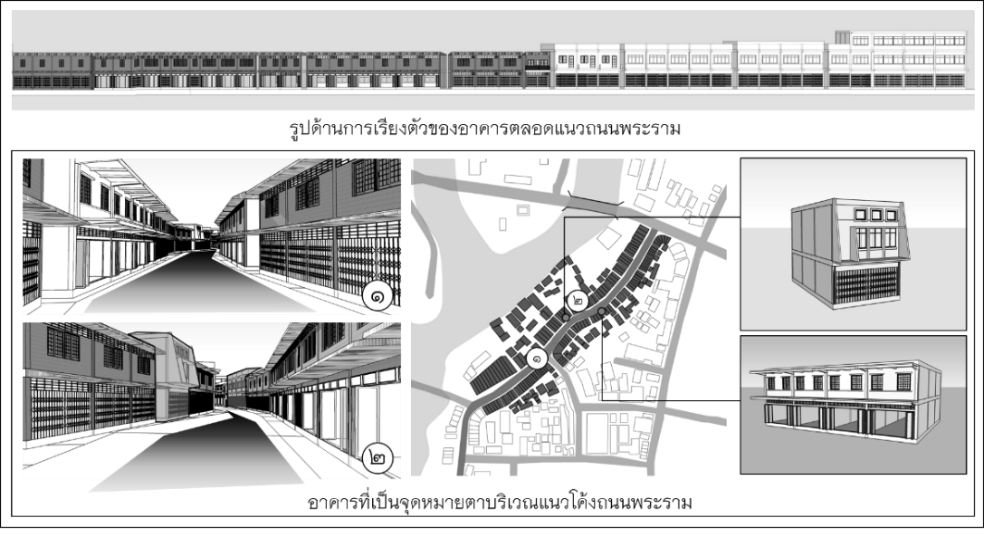Cultural Identity of Taladlang Community, Lopburi Province
Main Article Content
Abstract
The objectives of this research are to study the structure and elements of both tangible and intangible culture, and analyze and summarize the cultural identity of Taladlang Community in Lopburi province. The research uses a qualitative method to describe the cultural structure and elements that reflect the cultural identity of Taladlang Community. The results shows that Taladlang Community has 4 distinctive characteristics of cultural structures including the retention of community structure, landscape, landmark, and perspective. The retention of community structure, in particular, has unique physical structure and elements made by both human and nature.These play an important role in helping to promote the other distinctive characteristics of Taladlang Community. In term of the cultural elements,the result show that the value of physical elements (Building) promote the quality of the old community to Taladlang Community.Moreover, the analysis of the cultural structure and cultural elements show that Taladlang Community has unique and significant cultural elements in various aspects and can be culturally identified as “physical and architectural characteristics”. This reflection of the cultural identity of the Taladlang Community shows the significance in maintaining the history of the community and community way of life.
Downloads
Article Details

This work is licensed under a Creative Commons Attribution-NonCommercial-NoDerivatives 4.0 International License.
All material is licensed under the terms of the Creative Commons Attribution 4.0 International (CC-BY-NC-ND 4.0) License, unless otherwise stated. As such, authors are free to share, copy, and redistribute the material in any medium or format. The authors must give appropriate credit, provide a link to the license, and indicate if changes were made. The authors may do so in any reasonable manner, but not in any way that suggests the licensor endorses you or your use. The authors may not use the material for commercial purposes. If the authors remix, transform, or build upon the material, they may not distribute the modified material, unless permission is obtained from JARS. Final, accepted versions of the paper may be posted on third party repositories, provided appropriate acknowledgement to the original source is clearly noted.
References
Burke, G. (1976). Townscape. England: Pelican Books Ltd.
Dobby, A. (1978). Conservation and Planning. London: Hutchinson. Great Britain: Anchor Press Ltd.
Feilden, B. M. (2003). Conservation of historic buildings. (3rd ed.). London: Routledge.
Garnham, H.L. (1985). Maintaining the spirit of place: A Process for the preservation of town character. Mesa: PDA.
Khwansuwan, S. (2015). Traditional Communities: Definition, Value, Regeneration Mechanism to Everyday Life Practice. Journal of Faculty of Architecture, KMITL .Vol 17(20), 1-17.
Kitrackool, N. (1985). Settement geography. Bangkok: Odeon Store.
Natural and Cultural Environmental Conservation Department. (2005). Lopburi Old Town map. Lopburi: Thepsatri rajabhat university.
Nitikul, S. (2013). Ancient image of Lopburi legend. Bangkok: P.A. Living.
Office of Natural Resources and Environmantal Policy and Planning. (2005). System for Conservation Cultural environment. Bangkok: Office of Natural Resources and Environmantal Policy and Planning.
Office of Natural Resources and Environmantal Policy and Planning. (2012). Environmental Quality Standards Project Art of the old community In the central and eastern regions: quality standards, environmental arts, old community areas. Bangkok: Office of Natural Resources and Environmantal Policy and Planning.
Pama, T. and Haocharoen, K. (2017). Factors Affecting the Changes of Taladlang District, Lopburi Province. Journal of Faculty of Architecture, KMITL .Vol 19(25), 51-68.
Panin, O. (2001). The Indigenous shophouses in the urban area. Bangkok: J Princes.
Phongprayoon, C. (1993). Human settlements theory and guidelines. Bangkok: Chulalongkorn University Printing Press.
Pimolsathein, Y. (2012). Critical Issues on the Conservation of Historic Urban Community for Thailand. NAJUA:History of Architecture and Thai Architecture Journal. Department of Architecture and Related Arts,Faculty of Architecture, Silpakorn University. 9(2), 100-119.
Pumphit, N. Fried banana shop owner. (22 December 2018). Interview.
Sene Na Ayuddhaya, K. and Kirdsiri, K. (2016). Vernacular Rowhouse in Historic Urban Landscape of Talad Lang Rama Street, Lopburi Province. Academic Journal: Faculty of Architecture, Khon Kaen University. Volume. 15(1).
Spencer, J.E. and Thomas, W.L. Jr. (1969). Cultural geography: an evolutionary introduction to our humanized earth. New York: Wiley.


